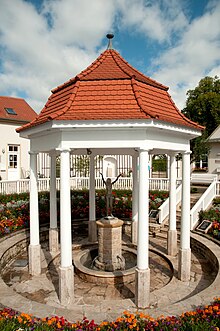Goethe fountain (Bad Berka)
The Goethe fountain - originally named after the sovereign Carl-August-Brunnen and later, after the mineral composition, steel fountain - is a fountain in the spa town of Bad Berka in Thuringia built with the support of Johann Wolfgang von Goethe in 1813 . The Goethe Fountain is one of the city's most famous sights and a cultural monument .
location
The Goethebrunnen is located about 300 meters east of the city center at the beginning of the Goetheallee , which is also the entrance to the Goethepark . It is only a few meters to the right bank of the Ilm .
history
The healing effects of the mineral springs at Berka were already known to the population in the 18th century. However, it is thanks to the teacher and organist Heinrich Friedrich Schütz from Berka who provided the decisive impetus for founding a bathing establishment. Duke Carl August , his Minister of State Goethe and with him the Weimar Court Society welcomed the plans to build a state-owned spa near the residential city of Weimar .
After the Duke had commissioned two Jena professors ( Döbereiner and Kieser) to assess the mineral springs, it was Goethe who presented the skeptical memorandum Promemoria on November 22, 1812 and initially hesitantly stood in the way of the project. Goethe already had concerns about the productivity of the sulfur spring, but also wanted to give new impetus to the economic development of the then impoverished town of Berka, which was often plagued by city fires and floods. He therefore agreed to give permission for the construction.
Opening in June 1813
At a conceivably inopportune time, on June 24, 1813, the bathing establishment was founded as the Carl-August-Brunnen . She initially offered a sulphurous medicinal water for baths and drinking cures as therapy. In 1813 203, in the following year 190 spa guests visited the place. Goethe, now a man in the 1960s, also visited the pool, for which he stayed with his wife in the city's noble courtyard . The bathing inspector Heinrich Friedrich Schütz took over the management of the institution . He found a lot of support from Goethe in his work. Dietrich Georg von Kieser worked as a well doctor . The steel bathhouse was built in 1835 and is now the seat of the tourist information office and the spa administration.
Setbacks
On the night of April 26, 1816, a major fire in the city destroyed 86 houses, 40 barns and 68 stables and outbuildings; almost two thirds of the city were destroyed.
Shortly after the catastrophe, Goethe arrived in the city and was able to win the duke over to a generous reconstruction program, which the architect Clemens Wenzeslaus Coudray , who has just entered the service of Weimar, will take over as chief construction manager. The classical building ensemble includes the area of the market square with the town hall, the armory, the rifle house and a few streets in the old town. Goethe also gives structural impulses: he helps the city to create a spa park. Even more - on June 24, 1825, the bathing house was opened with a splendid ball . After the natural sulfur healing spring in the park had dried up in 1840, the spa administration switched the bathing operations to the already well-known steel spring (because mineral water spring contains iron).
New course offers
In 1850, the Berka health resort administration introduced the administration of spruce and pine needle baths on a trial basis, and around 1870 whey drinking cures and mud baths were added. At the same time attempts were made to find new healing waters through deep drilling. This succeeded in 1877, but the boreholes soon caused an (undesirable) mixing of the deep water layers, and the new source was identified as mineral water containing calcium sulphate .
From 1888 the Sophienheilstätte for the treatment of lung diseases was founded on the Emskopf in the suburb of Munich . This started a new chapter in the history of the spa business in Bad Berka. When the GDR was founded in 1949, the fountain was renamed the Goethe-Brunnen .
To this day, the drinking and bathing cure is possible in Bad Berka.
Structural matters
Initially the bath consisted of the spring taken in 1813, the bath cell built next to it and some rooms for medical examinations and therapy. The steel bathhouse - today's drinking hall - was built in 1835 .
The current pavilion over the spring was built in 1909. The delicate fountain figure was created in 1950 by the artist Bruno Eyermann, who lives in Berka .
literature
- Hans Joachim Kessler: Healing water and bubbling springs. Encounters with historical baths in Thuringia . Ed .: Sparkassen-Kulturstiftung Hessen-Thüringen. E. Reinhold Verlag, Altenburg 2001, ISBN 3-910166-44-X , Das Bad Berkaer Quartet ..., p. 53-60 .
- Thuringian Open Air Museum Hohenfelden (Ed.): On the way in the Ilm valley. Interesting facts and information for tourists and locals . MFB-Verlagsgesellschaft, Eisenach 1998, ISBN 3-931431-10-X , The Goethe-Brunnen in Bad Berka, p. 56 .
Web links
Coordinates: 50 ° 53 ′ 54.3 " N , 11 ° 17 ′ 18.6" E


